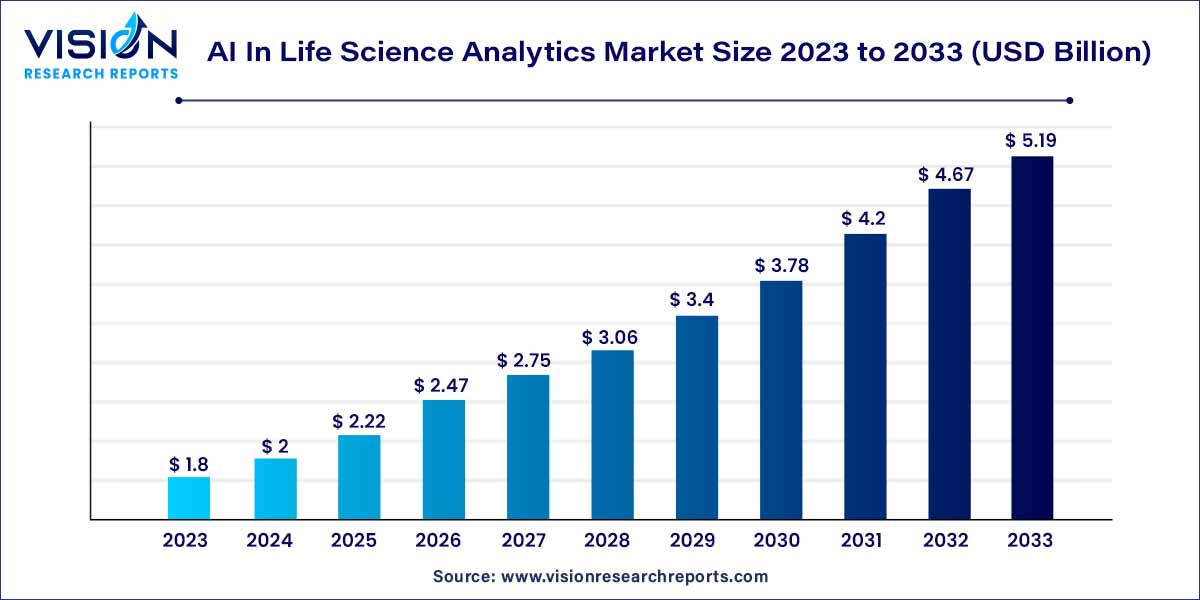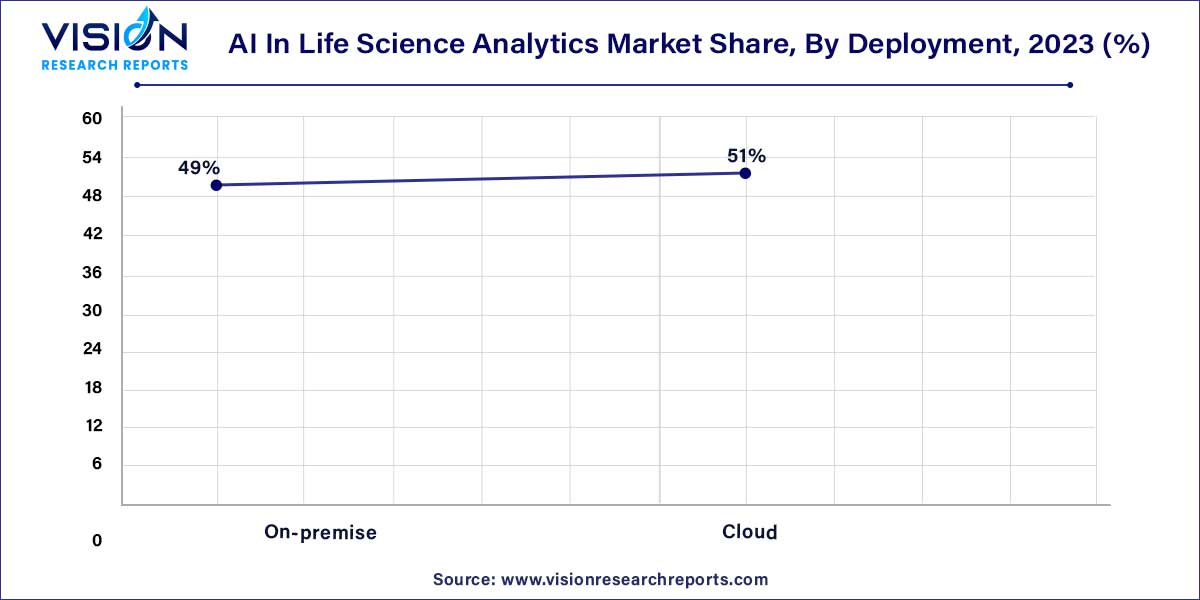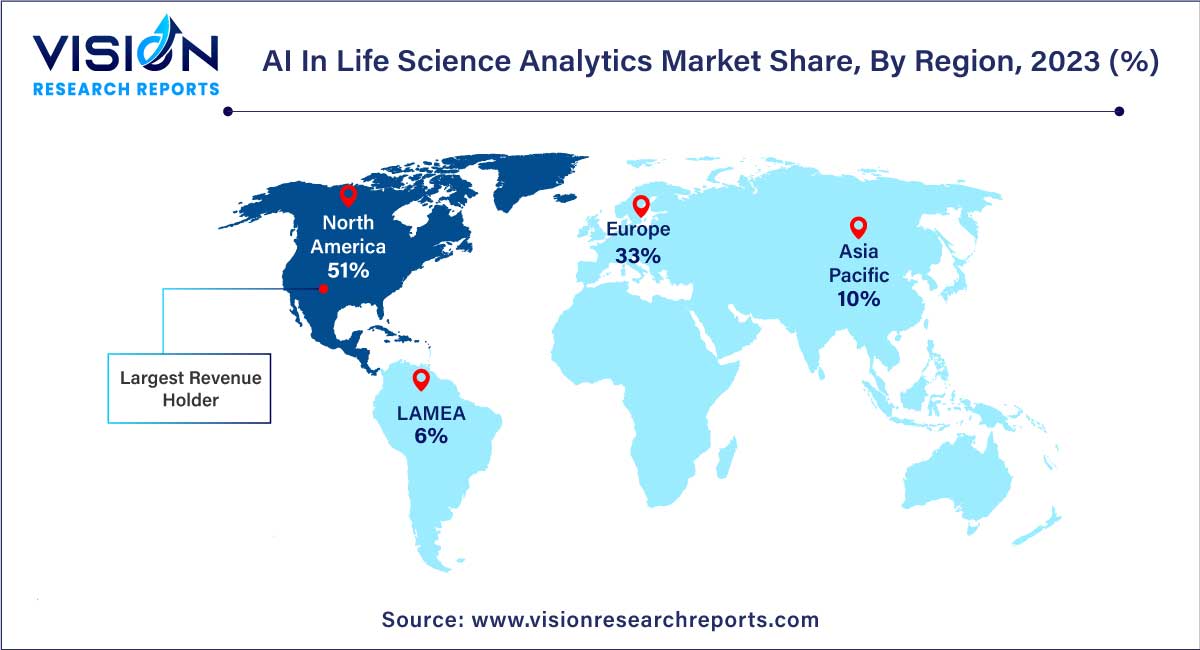The global AI in life science analytics market size was accounted for USD 1.8 billion in 2023 and is projected to hit around USD 5.19 billion by 2033 and expected to expand at a compound annual growth rate (CAGR) of 11.17% from 2024 to 2033.

In recent years, the Life Science Analytics market has witnessed a transformative shift with the integration of Artificial Intelligence (AI). This amalgamation has not only enhanced the efficiency of analytical processes but has also unlocked new avenues for innovation and discovery within the life sciences sector.
The exponential growth of the AI in Life Science Analytics market can be attributed to several key factors driving its expansion. Firstly, the increasing volume and complexity of life sciences data have necessitated advanced analytics tools, and AI's ability to efficiently process and derive insights from vast datasets has become indispensable. Additionally, the application of AI in predictive analytics for drug discovery has significantly expedited research and development processes, reducing both time and costs. The shift towards personalized medicine, facilitated by AI's analysis of individual genetic data, has further fueled market growth by improving treatment efficacy. Real-time monitoring and diagnostics, enabled by AI, contribute to early anomaly detection, enhancing patient care. The efficiency gains in clinical trials, from participant recruitment to predicting challenges, have positioned AI as a pivotal force in expediting research timelines. As a result, the market is witnessing substantial growth, supported by ongoing investments in AI technologies across pharmaceutical companies, research institutions, and healthcare providers.
In 2023, the service component segment dominated the market with a share of 38%. The service segment is also anticipated to record the fastest growth during the forecast period. The primary factor driving the growth of the segment is an increase in the trend of outsourcing services. The majority of companies lack proper analytic components, which makes it difficult for them to perform better and more accurate analyses; thus, outsourcing is extremely crucial. The use of analytics requires experts for analyzing the large amounts of data generated, which drives the demand for AI in order to analyze the data accurately and effectively, thereby driving the growth of the segment during the forecast period.
AI is gaining trust in the analytics field because it is capable of providing fast, precise, and reliable data on which companies can rely. As a result, companies are more interested in investing in the integration of artificial intelligence algorithms into analytical solutions. The expansion of data analytics companies' services and growing technological collaborations are positively impacting the growth of the segment.
The cloud segment dominated the market with a revenue share of 51% in 2023 and is anticipated to grow at the fastest rate during the forecast period. Factors contributing to this growth are high penetration of the internet, development of cloud-based services, adoption of cloud technologies, and shift in preference toward cloud-based technologies from on-premise technologies owing to benefits provided by the former. In addition, cloud-based AI services are ideal for many organizations because they eliminate the need for large data centers, which require a significant investment. As a result, cloud-based AI is cost-effective, thereby demonstrating lucrative growth.

Cloud-based AI ensures smooth workloads and automates repetitive processes, increasing overall efficiency. The major advantage of cloud-based AI deployment is that the organization can cut down the costs associated with hardware administration and maintenance. Furthermore, by utilizing reliable real-time data, AI significantly improves seamless data management.
By end-user, the pharmaceutical segment held the largest share of 47% in 2023. Factors such as the increasing adoption of AI tools in the process of manufacturing, clinical trials, and drug discovery are some of the factors driving the growth of the segment. The use of these tools can fast-track the discovery of new molecules, and considerably reduce cycle times and costs while improving clinical outcomes. Moreover, through the use of AI tools, pharmaceutical manufacturers can identify quality control issues, and predict the proven bottlenecks, which are expected to further drive the adoption of this technology.
The biotechnology segment is anticipated to witness lucrative growth during the forecast period owing to the advantages offered by the incorporation of this technology, such as accelerated R&D, effective decision-making, analysis of homogenous databases, and cost-effectiveness. Moreover, through the integration of these tools, biotechnology firms can improve their organizational workflows in order to gain competitive advantages. Furthermore, machine learning is used for interpreting large genomic data sequences and genomic data sets, which is expected to drive the growth of the segment during the forecast period.
The sales and marketing segment held the largest share of 33.5% in 2023. The factors that boost the growth are the benefits provided by AI such as marketing automation, increased personalization, reduced errors, as well as smart and faster decision-making abilities. The demand for analytical solutions is constantly increasing, thus the competition is also high, so to cope with the competition major organization that provides solutions are implementing AI in the sales and marketing department. AI effectively analyses customer data and automates repetitive tasks by utilizing its advanced algorithms.
During the forecast period, the research and development segment is expected to grow at the fastest rate. The rising adoption of analytical solutions in drug development and clinical trials is one of the driving factors for growth. Leading companies are constantly investing in the development of new innovative drugs for the treatment of severe diseases such as cancer, diabetes, and other infectious diseases that necessitate extensive research and development. As a result, the segment is expected to expand at a lucrative rate in the coming years.
North America dominated the market in 2023 with a revenue share of 51%. This growth is contributed by higher demand for AI technology, increased digital literacy as well as advancements in life science analytics in the region. Moreover, increasing initiatives undertaken by the governments and collaborations among government bodies and private players for the development of technological solutions are anticipated to drive market growth. Furthermore, the rapid adoption of the solutions by healthcare institutions in order to organize organizational workflows is anticipated to boost the market growth.

Asia Pacific is expected to witness the highest growth during the forecast period. The rising number of countries aiming to adopt AI-based tools and the extensive presence of biotech companies are the reasons that are fueling the growth of the market. Major players in Asia Pacific are more focused on the adoption of AI-based analytical tools to enhance operational efficiency, which also plays a crucial role in market growth.
By Component
By Deployment
By Application
By End-user
By Region
 Cross-segment Market Size and Analysis for
Mentioned Segments
Cross-segment Market Size and Analysis for
Mentioned Segments
 Additional Company Profiles (Upto 5 With No Cost)
Additional Company Profiles (Upto 5 With No Cost)
 Additional Countries (Apart From Mentioned Countries)
Additional Countries (Apart From Mentioned Countries)
 Country/Region-specific Report
Country/Region-specific Report
 Go To Market Strategy
Go To Market Strategy
 Region Specific Market Dynamics
Region Specific Market Dynamics Region Level Market Share
Region Level Market Share Import Export Analysis
Import Export Analysis Production Analysis
Production Analysis Others
Others